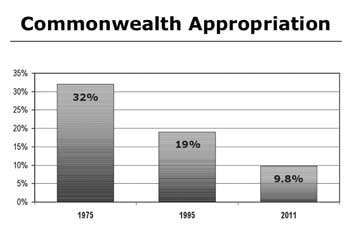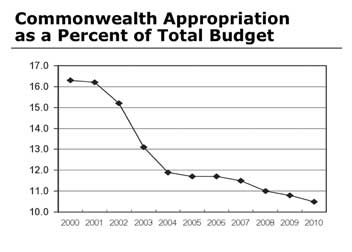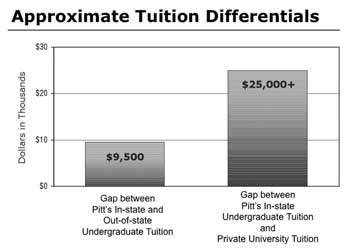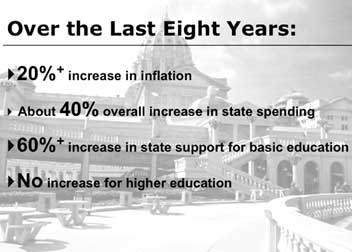Chancellor Says Pitt Willing to Accept “Fair Share Of Sacrifice” in Proposed Budget Cuts, but Asks PA Legislature Not to Abandon Higher-Education Funding
 Mark A. Nordenberg
Mark A. Nordenberg(This is Pitt Chancellor Mark A. Nordenberg’s written testimony that was submitted to the Senate’s Appropriation Committee on March 16, 2011. The Chancellor is making a presentation to the Pennsylvania House’s Appropriations Committee today, March 28.)
In the preamble to the Act of Feb. 28, 1787, which established the academy that would become the University of Pittsburgh, the Pennsylvania legislature declared that “the education of youth ought to be a primary object with every government.” For nearly 225 years, state support for Pitt has been built on a basic belief in the power of education, not only as an essential element of individual growth but also as a key to building community vitality and economic strength.
Forty-five years ago, when Pitt became a state-related university, the Commonwealth assumed a more central role in supporting high-quality programs of higher education. That new role created larger numbers of reasonably priced opportunities to meet the higher aspirations of Pennsylvania families. It also reflected the recognition that a competitive state economy would require an increasingly well-educated citizenry. The basic understanding was straightforward—the state would provide an appropriation large enough to enable Pitt to set a tuition rate for Pennsylvania students that was markedly lower than what it had been charging, and would have continued to charge, as a private university. In the process, the state also would provide support to an institution that would become increasingly central to the Commonwealth’s collective progress.
Unfortunately, levels of Commonwealth support have fallen significantly over an extended period of time—with our appropriation representing more than 30 percent of the University’s budget in the mid-1970s, less than 20 percent by the mid-1990s, and just under 10 percent today. Comparisons to the levels of support provided by many other states are striking. For example, most of the institutions that have been grouped with Pitt in the very top cluster of public research universities in the annual assessment of The Top American Research Universities enjoy markedly higher levels of support: Berkeley—26 percent; Florida—32 percent; North Carolina—22 percent; and Wisconsin—18 percent. Within that top group, only Michigan, at 7 percent, lagged behind Pitt.
 Pitt’s appropriation was cut in six of the last 10 fiscal years, and trend lines for the last eight years are revealing—with inflation rising by more than 20 percent, state spending increasing by nearly 40 percent, and state support for basic education climbing by more than 60 percent, but with support for higher education remaining flat. It is absolutely clear, then, that Pitt’s no-growth appropriation did not contribute in any way to what some have described as the state spending run-up of the last eight years. In fact, when inflation is factored in, the University suffered significant losses to the purchasing power of its appropriation.
Pitt’s appropriation was cut in six of the last 10 fiscal years, and trend lines for the last eight years are revealing—with inflation rising by more than 20 percent, state spending increasing by nearly 40 percent, and state support for basic education climbing by more than 60 percent, but with support for higher education remaining flat. It is absolutely clear, then, that Pitt’s no-growth appropriation did not contribute in any way to what some have described as the state spending run-up of the last eight years. In fact, when inflation is factored in, the University suffered significant losses to the purchasing power of its appropriation.
Even with this erosion in state support, Pitt has continued to honor its end of the tuition-differential agreement that sits at the heart of its state-related status. Pennsylvania is home to four universities that are members of the Association of American Universities, widely regarded as the top 63 research universities in the United States and Canada. Two—Pitt and Penn State—are public, and two—Carnegie Mellon and the University of Pennsylvania —are private.
 At Pitt, the tuition charged an undergraduate student enrolled at the University’s main campus is slightly in excess of $14,000 per year—which is high by national public university standards, reflecting comparatively low levels of state support. Penn State’s tuition is comparable. However, charges at our private AAU counterparts exceed $40,000 per year—a gap of more than $25,000. Put another way, that single-year gap between public and private university charges is almost enough to pay for two full years of Pitt’s in-state tuition.
At Pitt, the tuition charged an undergraduate student enrolled at the University’s main campus is slightly in excess of $14,000 per year—which is high by national public university standards, reflecting comparatively low levels of state support. Penn State’s tuition is comparable. However, charges at our private AAU counterparts exceed $40,000 per year—a gap of more than $25,000. Put another way, that single-year gap between public and private university charges is almost enough to pay for two full years of Pitt’s in-state tuition.
Unfortunately, the proposed budget for the next fiscal year would dramatically accelerate this pattern of erosion by slashing state support for public higher education, disadvantaging Pennsylvania families and putting the collective good of the Commonwealth in jeopardy. From our review of that proposal, the steep and sweeping cuts in support for Pitt would include:
• a 50 percent, or $80 million, reduction to our general education appropriation, funds that are used mainly to support the education of the next generation of Pennsylvanians;
• the complete elimination of nearly $17 million of support for programs in the health sciences, including our top-ranked School of Medicine, the Western Psychiatric Institute and Clinic, our Dental Clinic, and our Center for Public Health Practice;
• the apparent (because here the budget documents may be confusing) loss of annual biomedical research support, competitively awarded, of more than $9 million from the tobacco settlement fund; and
• the anticipated loss of more than $7.5 million in stimulus funding.
The short and sad message is that Pitt has been targeted for cuts in excess of $100 million.
 To be clear, the daunting budget deficit that Pennsylvania now faces was not created by the current administration, just as it was not created by Pitt, and it has been said that when seeking to close a $4 billion budget deficit there are no good choices. Even if that is true, however, there are better choices—or at least “less bad” choices—and the stunningly deep cuts proposed for higher education are not among them.
To be clear, the daunting budget deficit that Pennsylvania now faces was not created by the current administration, just as it was not created by Pitt, and it has been said that when seeking to close a $4 billion budget deficit there are no good choices. Even if that is true, however, there are better choices—or at least “less bad” choices—and the stunningly deep cuts proposed for higher education are not among them.
To frame the responsibilities of government in everyday terms, it has become customary to draw an analogy to the basic constraint faced by every family—the need to live within its means. But the comparison almost never extends to the even more telling aspects of the analogy —the values that shape family spending priorities and the parental struggles to advance those priorities once set. The families whose approaches to life we traditionally have honored are those in which the highest parental priority is helping to build the foundation for better lives for their daughters and sons—their next generation. As a society, we always have celebrated, in particular, the efforts of parents who sacrifice spending on themselves, or who find ways to generate more family income by taking on additional work, in order to provide their children with a college education.
Today, the application of the family analogy to governmental budgets rarely seems to reach that second stage. Elected officials do regularly say that we cannot, in good conscience, leave our children and grandchildren to deal with the crushing government debt that continues to grow, and it would be hard to disagree with that. But little attention is paid to the crushing personal debts that may be incurred by many members of our society’s next generation if public support for public higher education is further slashed. It also is rare for there to be any acknowledgment of the fact that our children and grandchildren will be less well equipped to deal with the world that we leave them if public higher education moves beyond the means of large segments of society.
 In the 1960s, the Commonwealth became an active partner in creating broader access to higher education. The most direct beneficiaries of its actions were the young people of my generation and their parents. We now seem on the verge of retreating from the responsibility to make such opportunities available, on at least roughly equivalent terms, to the young people of today.
In the 1960s, the Commonwealth became an active partner in creating broader access to higher education. The most direct beneficiaries of its actions were the young people of my generation and their parents. We now seem on the verge of retreating from the responsibility to make such opportunities available, on at least roughly equivalent terms, to the young people of today.
Of course, as noted, this is not just a matter of supporting the educational aspirations of individual citizens. It also is a matter of building collective strength, because Pennsylvania itself has been a major beneficiary of its investments in public higher education. In arguing for the creation of an academy in Pittsburgh some 225 years ago, our founder, a member of this Legislature, observed that “the strength of a state greatly consists in the superior mental powers of its inhabitants.” Whatever may have been the case in those frontier days, we all know how true that statement is today. And we also see tangible benefits that flow directly from the higher-education enterprise and extend beyond the general benefits of a well-educated citizenry.
Looking just at the impact of the University of Pittsburgh, those benefits include:
• an education and health services sector that is the largest and fastest-growing employment supersector in the greater Pittsburgh region;
• five vibrant campuses that are economic anchors in their home communities of Bradford, Greensburg, Johnstown, and Titusville, as well as Pittsburgh; and
• the impact of Pitt as a research powerhouse that imports more than four dollars in research funding for every one dollar of state appropriation (probably an unequaled return on state investment) and that is recognized as a primary source of the ideas that will define our economic future.
As important as building the economy of the future may be, these research initiatives also have the potential to produce other benefits that can only be described as amazing. Consider, for example, recent headlines announcing that Pitt researchers would receive nearly $7 million in federal support over the next three years to test two different types of brain implants designed to advance work that would permit paralyzed individuals, including our “wounded warriors,” to control prosthetic limbs through the power of their own thoughts. As we think about the world that we hope to leave to the next generation, are we really prepared to say, as a society, that work of this type will no longer be a priority? What would we think of our predecessors if they had not supported the Pitt-based efforts that led to the Salk polio vaccine or the development of the surgical techniques and drug therapies that made human organ transplantation possible?
As we engage in the process of setting the priorities that will shape more constrained public investments in the years ahead, we should return, again and again, to the wisdom of Benjamin Franklin. The man considered by many to be the greatest Pennsylvanian of all once said, “An investment in knowledge always pays the best interest.”
More than two centuries of intervening history have shown that Mr. Franklin was right about his civic investment strategy, just as he was right about so many other things. And Pitt’s recent history adds 21st-century meaning to Franklin’s 18th-century advice. Pioneering research advances, public service initiatives of impact, and programs that permit current students to use the power of education to build better lives have become broadly recognized and widely respected hallmarks of the University of Pittsburgh.
To be absolutely clear, the University stands ready, as it always has, to accept its fair share of the sacrifice that will be required to rein in the deficit. Evidence of that fact can be found in the existing record. As noted above, the University’s appropriation has been cut in six of the last 10 years. However, the cuts now proposed are disproportionately deep and would not only do damage to the dreams of young Pennsylvanians and to the plans of their families but would undermine much of the progress that has been made to position the Commonwealth for future success in the emerging innovation economy.
As we enter a new era of government, we must work together not only to find ways to shrink our accumulated budget deficits, which we know must be done. We also must search for ways to secure the progress that is the key to our shared future. For nearly 225 years, Pitt has been a powerful force in building brighter futures. As we move further into a new century characterized by a rapidly changing and highly competitive world and faced with the need to nurture a vibrant society and to rebuild a strong and sustainable economy, Pennsylvania cannot afford to let that light go dim. Regrettably, the dramatic budget cuts that have been proposed would do just that.
Other Stories From This Issue
On the Freedom Road

Follow a group of Pitt students on the Returning to the Roots of Civil Rights bus tour, a nine-day, 2,300-mile journey crisscrossing five states.
Day 1: The Awakening
Day 2: Deep Impressions
Day 3: Music, Montgomery, and More
Day 4: Looking Back, Looking Forward
Day 5: Learning to Remember
Day 6: The Mountaintop
Day 7: Slavery and Beyond
Day 8: Lessons to Bring Home
Day 9: Final Lessons

